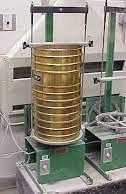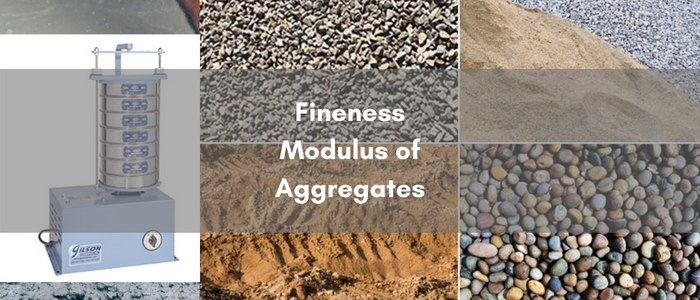The fineness modulus (FM) of aggregates can be confusing at the beginning. In this article, we will walk you through what FM means and how it is simply calculated.
What is Fineness Modulus of aggregates?
Basically, the Fineness modulus of aggregates is an empirical value, which means it is derived from or relating to experiment and observation rather than theory.
The purpose of the FM value is to describe the the average size of particles in a given sample of aggregate.
This factor (FM) is needed for us in the process of mix design to help determine the amount of aggregates required in a concrete mixture.
The fineness modulus can be either for fine aggregate (such as sand) or coarse aggregate (such as gravel) but most of the time it is used for sand because when designing concrete mixes, the FM of the fine aggregate is required for the effective proportioning of mixes.
So the fineness modulus of sand can be defined as the index number that provides the mean size of particles exist in a sand sample.
Principle for Fineness Modulus of Aggregates Measurement
To calculate the Fineness modulus, we first need to do a sieve analysis test using standard sieves according to the code you are following. For example, the sieves used for sand can be 4.75mm, 2.36, 1.18, 600 μm, 300 μm and 150 μm from top to bottom. The amount of retained materials is measured for each sieve size. Then the cumulative retained percentage for all sieves is summed and divided by 100.
In other words, the FM is a factor obtained by adding the percentage of material in the sample that is coarser than each of the following sieves (cumulative percentage retained) and dividing the sum by 100.
Sieve Analysis
As we mentioned, sieve analysis, which determines the gradation (the distribution of aggregate particles, by size, within a given sample), is needed to be performed before calculating the FM. Sieve analysis is done on a dry sample (drying at 100 – 110oC).
Sieves are arranged such that the largest size is placed at top and going downwards, the size is reduced. The pan (does not have any openings) is placed at the bottom.

If you are using a mechanical shaking table (this is usually the case), cover the top sieve with a lid and start shaking. The period of shaking will depend on the code you are following.
Sometimes, you may not have a mechanical shaker, so you will need to do the shaking with hand. You will shake two sieves together starting from the top two going downwards.
Shake the sieves inwards and outwards, vertically and horizontally.
Measure the amount of material retained on each sieve and sum the values to get the cumulative retained weight.
Divide cumulative retained weight / 100 to get the fineness modulus.
Examples of Fineness Modulus Calculation
Example 1:
Let us assume that the results for the sieve analysis of 100% sample is as shown in the following table:
| Sieve size | Percentage of Individual Fraction Retained, by Weight | Cumulative Percentage Passing, by Weight | Cumulative Percentage Retained, by Weight |
| 9.5 mm | 0 | 100 | 0 |
| 4.75 mm | 2 | 98 | 2 |
| 2.36 mm | 13 | 85 | 15 |
| 1.18 mm | 20 | 65 | 35 |
| 600 μm | 20 | 45 | 55 |
| 300 μm | 24 | 21 | 79 |
| 150 μm | 18 | 3 | 97 |
| Pan Total | 3 | 0 | |
| Sum | 100 | 283 |
Thus, we take the sum of cumulative percentage retained on all sieves without the pan
Cumulative percentage = 0 + 2 + 15 + 35 + 55 +79 +97 = 283
FM = Cumulative percentage / 100 = 283 / 100 = 2.83 [no unit].
This value means that the average size of the aggregate samples lies between the second and third sieves from the bottom (closer to the third). In our examples, the second sieve was 300 μm and the third was 600 μm.
Example 2:
| Sieve size | Mass Retained (grams) | Cumulative Mass Retained (grams) | Cumulative Percentage Retained (%) |
| 4.75 mm | 31.5 | 31.5 | 6.3 |
| 2.36 mm | 67.6 | 99.1 | 19.8 |
| 1.18 mm | 96.5 | 195.6 | 39.1 |
| 600 μm | 111.1 | 306.7 | 61.3 |
| 300 μm | 60.5 | 367.2 | 73.4 |
| 150 μm | 115.6 | 482.8 | 96.5 |
| Pan Total | 17.5 | 500.3 | |
| Sum | 500.3 (sample size) | 296.4 |
Cumulative percentage = 6.3 + 19.8 + 39.1 + 61.3 + 73.4 + 96.5 = 296.4
FM = Cumulative percentage / 100 = 296.4/ 100 = 2.96
Typical Values of FM of Sand
The maximum value of FM for sand should be 3.2. Aggregate with FM higher than 3.2 should not be considered as Fine aggregate. The fineness modulus of sand ranges between 2.2 to 3.2 depending on the fineness of sand. Fine sand has a FM range of 2.2-2.6; Medium sand from 2.6-2.9 and coarse sand from 2.9-3.2.
How FM affects Mix Design of Concrete
Now we know what the fineness modulus is and how to calculate it. Let us look at its importance related to the mixture design of concrete.
Fineness modulus describes the gradation curve in addition to the texture and uniformity of the sample material. The lower the FM value is, the finer is the sample on average.
Additionally, FM of the fine aggregate portion has a significant role in predicting other properties of both plastic and hardened concrete, including as workability, finish ability, shrinkage, porosity, permeability, strength, and fracture susceptibility.
A higher FM index denotes coarser aggregate that will result in a “harsh” mix that is more likely to segregate and challenging to appropriately place and finish. A low FM suggests finer material, which will call for more cement and require more water. This blend will cost more, be more expensive to put and finish, and have a higher risk of early age cracking.
There is a sweet spot that produces the best outcomes. For the majority of mixes, concrete that is simple to place, simple to finish, and less prone to fracture is produced by using FM of fine aggregate between 2.5 and 3.0. According to ASTM C33, the FM of fine aggregate has to be in the range of 2.3 and 3.1, and the FM of the finished batch of concrete cannot deviate from the design mix by more than 0.2. In mixes with high cement contents, it has been shown that fine aggregate FM’s at the upper end of the range, closer to 3.0, generate concrete with good strength and workability.
To summarise, fineness modulus (FM) is a tool for analysing aggregate gradations, modifying proportions, and managing the characteristics of finished mixes in addition to being necessary for complete, practical concrete mix designs.
Read Also:
